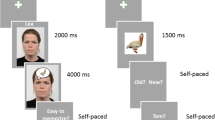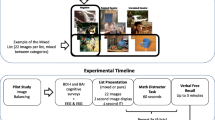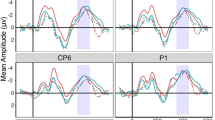Abstract
Background
Little is known about how rapid electrocortical responses (event-related potentials; ERPs) to affective pictures are modulated by benzodiazepine agonists. The present study investigated effects of oxazepam (20 mg p.o.) on behavioral measures and ERPs associated with affective picture processing during perception and recognition memory retrieval.
Methods
Forty-three healthy young adults were given oxazepam or placebo treatment under a double-blind experimental procedure. Affective pictures (negatively arousing or neutral) elicited ERP responses and participants rated pictures for emotionality (during incidental encoding) and recognition.
Results
Oxazepam did not affect perceptual (P1, P2) or emotional (early posterior negativity and late parietal positivity) ERPs or ratings during perception. However, oxazepam impaired recognition performance and decreased positive mid-frontal ERP component at 420–450 ms for old vs. new pictures. The memory impairment was retained at the delayed memory test.
Conclusions
Oxazepam does not selectively influence electrocortical or perceptual indexes of emotional perception or emotional memory. Rather, it blocks memory consolidation independent of valence category. These findings indicate that ERPs can be of use in assessing effects of benzodiazepines on memory-related processes.

Similar content being viewed by others
References
Amrhein C, Muhlberger A, Pauli P, Wiedemann G (2004) Modulation of event-related brain potentials during affective picture processing: a complement to startle reflex and skin conductance response? Int J Psychophysiol 54(3):231–240
Anderson AK, Yamaguchi Y, Grabski W, Lacka D (2006) Emotional memories are not all created equal: evidence for selective memory enhancement. Learn Mem 13(6):711–718
Basile AS, Lippa AS, Skolnick P (2004) Anxioselective anxiolytics: can less be more? Eur J Pharmacol 500(1–3):441–451
Bradley MM (2009) Natural selective attention: orienting and emotion. Psychophysiology 46:1–11
Bradley MM, Hamby S, Low A, Lang PJ (2007) Brain potentials in perception: picture complexity and emotional arousal. Psychophysiology 44(3):364–373
Braestrup C, Albrechtsen R, Squires RF (1977) High densities of benzodiazepine receptors in human cortical areas. Nature 269(5630):702–704
Bustos SG, Maldonado H, Molina VA (2009) Disruptive effect of midazolam on fear memory reconsolidation: decisive influence of reactivation time span and memory age. Neuropsychopharmacology 34(2):446–457
Cerro SD, Jung M, Lynch G (1992) Benzodiazepines block long-term potentiation in rat hippocampal and piriform corex slices. Neuroscience 49:1–6
Coupland NJ, Singh AJ, Sustrik RA, Ting P, Blair RJ (2003) Effects of diazepam on facial emotion recognition. J Psychiatry Neurosci 28(6):452–463
Curran HV (1986) Tranquilizing memories—a review of the effects of benzodiazepines on human memory. Biol Psychol 23(2):179–213
Curran HV (1991) Benzodiazepines, memory and mood—a review. Psychopharmacology 105(1):1–8
Curran T, Cleary AM (2003) Using ERPs to dissociate recollection from familiarity in picture recognition. Cogn Brain Res 15(2):191–205
Curran HV, Schiwy W, Lader M (1987) Differential amnesic properties of benzodiazepines: a dose-response comparison of two drugs with similar elimination half-lives. Psychopharmacology 92(3):358–364
Cuthbert BN, Schupp HT, Bradley MM, Birbaumer N, Lang PJ (2000) Brain potentials in affective picture processing: covariation with autonomic arousal and affective report. Biol Psychol 52(2):95–111
Davidson RJ (1998) Affective style and affective disorders: perspectives from affective neuroscience. Cogn Emotion 12(3):307–330
Gospic K, Gunnarsson T, Fransson P, Ingvar M, Lindefors N, Petrovic P (2008) Emotional perception modulated by an opioid and a cholecystokinin agonist. Psychopharmacology 197(2):295–307
Gustavsson JP, Bergman H, Edman G, Ekselius L, von Knorring L, Linder J (2000) Swedish universities scales of personality (SSP): construction, internal consistency and normative data. Acta Psychiatr Scand 102(3):217–225
Heinze HJ, Luck SJ, Mangun GR, Hillyard SA (1990) Visual event-related potentials index focused attention within bilateral stimulus arrays.1. Evidence for early selection. Electroencephalogr Clin Neurophysiol 75(6):511–527
Hoffmann O, Mossberg L, Heine L (2006) Benzodiazepine treatment in criminal medicine: careful control and strong indications are required. Lakartidningen 103(28–29):2131–2134
Johannes S, Wieringa BM, Nager W, Dengler R, Munte TF (2001) Oxazepam alters action monitoring. Psychopharmacology 155(1):100–106
Junghoefer M, Perlstein WM, Schupp HT, Keil A, Sabatinelli D, Bradley MM et al (2000) Emotional picture processing: research with dense array EEG. Psychophysiology 37:S17–S17
Kamboj SK, Curran HV (2006) Neutral and emotional episodic memory: global impairment after lorazepam or scopolamine. Psychopharmacology 188(4):482–488
Kleinsmith LJ, Kaplan S (1963) Paired-associate learning as a function of arousal and interpolated interval. J Exp Psychol 65(2):190–193
Lang PJ, Bradley MM, Cuthbert BN (2008). International affective picture system (IAPS): affective ratings of pictures and instruction manual. Technical Report A-8. University of Florida, Gainsville, FL
Luck SJ (2005) An introduction to the event-related potential technique. MIT Press, Cambridge
Luck SJ, Hillyard SA (1994) Electrophysiological correlates of feature analysis during visual-search. [Article]. Psychophysiology 31(3):291–308
Luck SJ, Woodman GF, Vogel EK (2000) Event-related potential studies of attention. Trends Cogn Sci 4(11):432–440
Murphy SE, Downham C, Cowen PJ, Harmer CJ (2008) Direct effects of diazepam on emotional processing in healthy volunteers. Psychopharmacology 199(4):503–513
Murray MM, Brunet D, Michel CM (2008) Topographic ERP analyses: a step-by-step tutorial review. Brain Topogr 20(4):249–264
Ochsner KN (2000) Are affective events richly recollected or simply familiar? The experience and process of recognizing feelings past. J Exp Psychol Gen 129(2):242–261
Olofsson JK, Polich J (2007) Affective visual event-related potentials: arousal, repetition, and time-on-task. Biol Psychol 75(1):101–108
Olofsson JK, Nordin S, Sequeira H, Polich J (2008) Affective picture processing: an integrative review of ERP findings. Biol Psychol 77(3):247–265
Patrick CJ, Berthot BD, Moore JD (1996) Diazepam blocks fear-potentiated startle in humans. J Abnorm Psychol 105(1):89–96
Petrovic P, Dietrich T, Fransson P, Andersson J, Carlsson K, Ingvar M (2005) Placebo in emotional processing—induced expectations of anxiety relief activate a generalized modulatory network. Neuron 46(6):957–969
Peyk P, Schupp HT, Keil A, Elbert T, Junghofer M (2009) Parallel processing of affective visual stimuli. Psychophysiology 46(1):200–208
Rozenkrants B, Olofsson JK, Polich J (2008) Affective visual event-related potentials: arousal, valence, and repetition effects for normal and distorted pictures. Int J Psychophysiol 67(2):114–123
Rugg MD, Curran T (2007) Event-related potentials and recognition memory. Trends Cogn Sci 11(6):251–257
Rugg MD, Wilding EL (2000) Retrieval processing and episodic memory. Trends Cogn Sci 4(3):108–115
Rugg MD, Mark RE, Walla P, Schloerscheidt AM, Birch CS, Allan K (1998) Dissociation of the neural correlates of implicit and explicit memory. Nature 392(6676):595–598
Sabatinelli D, Lang PJ, Keil A, Bradley MM (2007) Emotional perception: correlation of functional MRI and event-related potentials. Cereb Cortex 17(5):1085–1091
Sara SJ (2009) The locus coeruleus and noradrenergic modulation of cognition. Nat Rev Neurosci 10(3):211–223
Schupp H, Flaisch T, Stockburger J, Junghöfer M (2006) Emotion and attention: event-related brain potential studies. In: Anders, Ende, Junghöfer, Kissler & Wildgruber (Eds.), Progress in Brain Research, vol. 156. Elsevier Science: Boston, pp 31–51
Spielberger CD (1983) Manual for the state–trait anxiety inventory STAI. Mind Garden, Palo Alto
Sutton S, Braren M, Zubin J, John ER (1965) Evoked-potential correlates of stimulus uncertainty. Science 150(3700):1187
Ulrich-Lai YM, Herman JP (2009) Neural regulation of endocrine and autonomic stress responses. Nat Rev Neurosci 10(6):397–409
Walker MP, van der Helm E (2009) Overnight therapy? The role of sleep in emotional brain processing. Psychol Bull 135(5):731–748
Van Strien JW, Langeslag SJE, Strekalova NJ, Gootjes L, Franken IHA (2009) Valence interacts with the early ERP old/new effect and arousal with the sustained ERP old/new effect for affective pictures. Brain Res 1251:223–235
Vanleeuwen TH, Verbaten MN, Koelega HS, Camfferman G, Vandergugten J, Slangen JL (1994) Effects of oxazepam on performance and event-related brain potentials in vigilance tasks with static and dynamic stimuli. Psychopharmacology 116(4):499–507
Vanleeuwen TH, Verbaten MN, Koelega HS, Slangen JL, Vandergugten J, Camfferman G (1995) Effects of oxazepam or event-related brain potentials, eeg frequency bands, and vigilance performance. Psychopharmacology 122(3):244–262
Watson D, Clark LA, Tellegen A (1988) Development and validation of brief measures of positive and negative affect—the panas scales. J Pers Soc Psychol 54(6):1063–1070
Vuilleumier P, Pourtois G (2007) Distributed and interactive brain mechanisms during emotion face perception: evidence from functional neuroimaging. Neuropsychologia 45(1):174–194
Yonelinas AP, Otten LJ, Shaw KN, Rugg MD (2005) Separating the brain regions involved in recollection and familiarity in recognition memory. J Neurosci 25(11):3002–3008
Acknowledgments
We thank Anders Sand for excellent assistance during the stimulus evaluation and data processing phases of the study.
Author information
Authors and Affiliations
Corresponding author
Electronic supplementary material
Below is the link to the electronic supplementary material.
Supplementary Figure 1
ERP responses to IAPS pictures (negative and neutral) in participants treated with oxazepam (OX) and placebo (PL). Top panel shows EPN component and bottom panel shows LPP component (headplots show electrode clusters in purple). (DOC 1570 kb)
Supplementary Figure 1
Mean amplitudes (95% CI) of the EPN (upper panel) and LPP components (lower panel) during picture viewing and memory sessions (electrode cluster shown in green on headplots; note that component amplitudes are plotted as negative minus neutral condition and that components elicited by old and new stimuli are shown separately in graph). (DOC 1846 kb)
Rights and permissions
About this article
Cite this article
Olofsson, J.K., Gospic, K., Petrovic, P. et al. Effects of oxazepam on affective perception, recognition, and event-related potentials. Psychopharmacology 215, 301–309 (2011). https://doi.org/10.1007/s00213-010-2141-z
Received:
Accepted:
Published:
Issue Date:
DOI: https://doi.org/10.1007/s00213-010-2141-z




